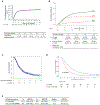Recurrence After Resection of Pancreatic Cancer: Can Radiomics Predict Patients at Greatest Risk of Liver Metastasis?
- PMID: 35366706
- PMCID: PMC9253095
- DOI: 10.1245/s10434-022-11579-0
Recurrence After Resection of Pancreatic Cancer: Can Radiomics Predict Patients at Greatest Risk of Liver Metastasis?
Abstract
Background: Liver metastasis (LM) after pancreatic ductal adenocarcinoma (PDAC) resection is common but difficult to predict and has grave prognosis. We combined preoperative clinicopathological variables and quantitative analysis of computed tomography (CT) imaging to predict early LM.
Methods: We retrospectively evaluated patients with PDAC submitted to resection between 2005 and 2014 and identified clinicopathological variables associated with early LM. We performed liver radiomic analysis on preoperative contrast-enhanced CT scans and developed a logistic regression classifier to predict early LM (< 6 months).
Results: In 688 resected PDAC patients, there were 516 recurrences (75%). The cumulative incidence of LM at 5 years was 41%, and patients who developed LM first (n = 194) had the lowest 1-year overall survival (OS) (34%), compared with 322 patients who developed extrahepatic recurrence first (61%). Independent predictors of time to LM included poor tumor differentiation (hazard ratio (HR) = 2.30; P < 0.001), large tumor size (HR = 1.17 per 2-cm increase; P = 0.048), lymphovascular invasion (HR = 1.50; P = 0.015), and liver Fibrosis-4 score (HR = 0.89 per 1-unit increase; P = 0.029) on multivariate analysis. A model using radiomic variables that reflect hepatic parenchymal heterogeneity identified patients at risk for early LM with an area under the receiver operating characteristic curve (AUC) of 0.71; the performance of the model was improved by incorporating preoperative clinicopathological variables (tumor size and differentiation status; AUC = 0.74, negative predictive value (NPV) = 0.86).
Conclusions: We confirm the adverse survival impact of early LM after resection of PDAC. We further show that a model using radiomic data from preoperative imaging combined with tumor-related variables has great potential for identifying patients at high risk for LM and may help guide treatment selection.
© 2022. Society of Surgical Oncology.
Conflict of interest statement
Figures




Comment in
-
ASO Author Reflections: Predicting Pancreatic Cancer Liver Metastasis by Integrating Primary Tumor Clinicopathologic Features and Liver Radiomics.Ann Surg Oncol. 2022 Aug;29(8):4975-4976. doi: 10.1245/s10434-022-11653-7. Epub 2022 Apr 5. Ann Surg Oncol. 2022. PMID: 35381934 Free PMC article. No abstract available.
References
-
- Siegel RL, Miller KD, Jemal A. Cancer statistics, 2018. CA Cancer J. Clin Jan 2018;68(1):7–30. - PubMed
-
- Hishinuma S, Ogata Y, Tomikawa M, Ozawa I, Hirabayashi K, Igarashi S. Patterns of recurrence after curative resection of pancreatic cancer, based on autopsy findings. J. Gastrointest. Surg Apr 2006;10(4):511–518. - PubMed
-
- Kayahara M, Nagakawa T, Ueno K, Ohta T, Takeda T, Miyazaki I. An evaluation of radical resection for pancreatic cancer based on the mode of recurrence as determined by autopsy and diagnostic imaging. Cancer Oct 1 1993;72(7):2118–2123. - PubMed
-
- Tani M, Kawai M, Miyazawa M, et al. Liver metastasis as an initial recurrence has no impact on the survival of patients with resectable pancreatic adenocarcinoma. Langenbecks Arch. Surg Mar 2009;394(2):249–253. - PubMed
MeSH terms
Grants and funding
LinkOut - more resources
Full Text Sources
Medical

